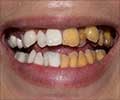
The study by Elfrink et al was embedded in the Generation R Study, a population-based prospective cohort study from fetal life until young adulthood. This study focused on the relationship between deciduous molar hypomineralization (DMH) and permanent molar incisor hypomineralization (MIH). First permanent molars develop during a period similar to that of second primary molars, with possible comparable risk factors for hypomineralization. Children with DMH have a greater risk of developing MIH. In this study, clinical photographs of clean, moist teeth were taken with an intra-oral camera in 6,161 children (49.8% girls; mean age 74.3 mos, SD ± 5.8). First permanent molars and second primary molars were scored with respect to DMH or MIH. The prevalence of DMH and MIH was 9.0% and 8.7% at child level, and 4.0% and 5.4% at tooth level. The odds ratio for MIH based on DMH was 4.4 (95% CI, 3.1-6.4). The relationship between the occurrence of DMH and MIH suggests a shared cause and indicates that, clinically, DMH can be used as a predictor for MIH.
"Data from over 6,000 children show that children with hypomineralization in the deciduous dentition (DMH: prevalence 9.0%) have a greater risk of developing hypomineralization in the permanent dentition (MIH; prevalence 8.7%)," said J.M. ten Cate, professor at Academisch Centrum Tandheelkunde Amsterdam and co-author of the study titled "Deciduous Molar Hypomineralization and Molar Incisor Hypomineralization". "Therefore, in clinical practice, extra attention needs to be paid to children with DMH in the period when their permanent molars and incisors are erupting, given their increased risk of having MIH."
Satu Alaluusua, University of Helsinki, Institute of Dentistry, Finland, wrote a corresponding perspective article entitled "Defining Developmental Enamel Defect-Associated Caries: Where are we now?" In it, she states that it would be of value to distinguish hypoplasia associated severe early childhood careers as a subgroup of S-ECC and she emphasizes that developmental enamel defects whether hypoplasia, hypomineralization or in combination can increase caries risk.
Source-Eurekalert








